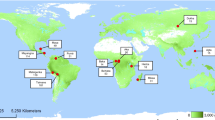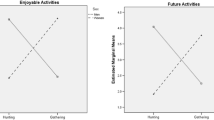Abstract
Humans have a much longer juvenile period (weaning to first reproduction, 14 or more years) than their closest relatives (chimpanzees, 8 years). Three explanations are prominent in the literature. (a) Humans need the extra time to learn their complex subsistence techniques. (b) Among mammals, since length of the juvenile period bears a constant relationship to adult lifespan, the human juvenile period is just as expected. We therefore only need to explain the elongated adult lifespan, which can be explained by the opportunity for older individuals to increase their fitness by providing for grandchildren. (c) The recent model by Kaplan and colleagues suggests that longevity and investment in "embodied capital" will coevolve, and that the need to learn subsistence technology contributed to selection for our extended lifespan.
We report experiments designed to test the first explanation: human subsistence technology takes many years to learn, and spending more time learning it gives reproductive benefits that outweight lost time. Taking away some of this time should lead to deficits in efficiency. We paid Hadza foragers to participate in tests of important subsistence skills. We compared efficiency of males and females at digging tubers. They differ greatly in time spent practicing digging but show no difference in efficiency. Children who lost "bush experience" by spending years in boarding school performed no worse at digging tubers or target archery than those who had spent their entire lives in the bush. Climbing baobab trees, an important and dangerous skill, showed no change with age among those who attempted it. We could show no effects of practice time.
These findings do not support what we label "the practice theory," but we discuss ways in which the theory could be defended; for example, some as-yet-untested skill may be greatly impaired by loss of a few years of the juvenile period. Our data also show that it is not safe to assume that increases in skill with age are entirely due to learning or practice; they may instead be due to increases in size and strength.
Similar content being viewed by others
References
Alvarez, Helen 2000 Grandmother Hypothesis and Primate Life Histories. American Journal of Physical Anthropology 113:435–450.
Bennett, F. J., N. A. Barnicot, J. C. Woodburn, M. S. Pereira, and B. E. Henderson 1973 Studies on Viral, Bacterial, Rickettsial, and Treponemal Diseases of the Hadza of Tanzania, and a Note on Injuries. Human Biology 45:243–227.
Bird, D. W., and R. Bliege Bird 2000 The Ethnoarchaeology of Juvenile Foragers: Shellfishing Strategies among Merriam Children. Journal of Anthropological Archaeology 19:461–476.
2002 Children on the Reef: Slow Learning or Strategic Foraging? Human Nature 13:269–297.
Bjorklund, D. F. 1997 The Role of Immaturity in Human Development. Psychological Bulletin 122:153–169.
Bliege Bird, R., and D. W. Bird 2002 Constraints of Knowing or Constraints of Growing? Fishing and Collecting by the Children of Mer. Human Nature 13:239–267.
Blurton Jones, N. G., and M. J. Konner 1976 !Kung Knowledge of Animal Behavior. In Kalahari Hunter-gatherers, R. B. Lee and I. DeVore, eds. Pp. 325–348. Cambridge: Harvard University Press.
Blurton Jones, N. G., K. Hawkes, and J. F. O’Connell 1989 Modelling and measuring costs of children in two foraging societies. In Comparative Socioecology, V. Stander and R. A. Foley, eds. Pp. 367–390. Oxford: Blackwell Scientific.
1997 Why Do Hadza Children Forage? In Genetic, Ethological and Evolutionary Perspectives on Human Development, N. L. Segal, G. E. Weisfeld, and C. C. Weisfeld, eds. Pp. 279–313. Washington, D.C.: American Psychological Association.
Bock, J. A. 1995 The Determinants of Variation in Children’s Activities in a Southern African Community. Ph.D. Dissertation, University of New Mexico, Albuquerque.
2002 Learning, Life History, and Productivity: Children’s Lives in the Okavango Delta, Botswana. Human Nature 13:161–197.
Bogin, B. 1999 Patterns of Human Growth. Cambridge: Cambridge University Press.
Bolby, John 1969 Attachment. Attachment and Loss, Vol. 1. London: Hogarth Press.
Charnov, E. L. 1993 Life History Invariants. Oxford: Oxford University Press.
2001 Evolution of Mammal Life Histories. Evolutionary Ecology Research 3:521–535.
Cooper, B. 1949 The Kindiga. Tanganyika Notes and Records 27:8–15.
Hammer, M. L. A., and R. A. Foley 1996 Longevity and Life History in Hominid Evolution. Human Evolution 11: 61–66.
Hawkes, Kristen, James F. O’Connell, and Nicholas G. Blurton Jones 1989 Hardworking Hadza Grandmothers. In Comparative Socioecology, V. Standen and R. A. Foley, eds. Pp. 341–366. Oxford: Blackwell.
1995 Hadza Children’s Foraging: Juvenile Dependency, Social Arrangements, and Mobility among Hunter-gatherers. Current Anthropology 36:688–700.
1997 Hadza Women’s Time Allocation, Offspring Provisioning, and the Evolution of Long Post-menopausal Lifespans. Current Anthropology 38:551–577.
2002 The Evolution of Human Life Histories: Primate Trade-offs, Grandmothering Socioecology, and the Fossil Record. In Primate Life Histories and Socioecology, Peter M. Kappeler and Michael E. Pereira, eds. Chicago: University of Chicago Press, in press.
Hawkes, Kristen, James F. O’Connell, Nicholas G. Blurton Jones, Helen Alvarez, and Eric L. Charnov 1998 Grandmothering, Menopause, and the Evolution of Human Life Histories. Proceedings of the National Academy of Sciences, USA 95:1336–1339.
Hill, Kim 1982 Hunting and Human Evolution. Journal of Human Evolution 11:521–544.
Hill, K., and A. M. Hurtado 1996 Ache Life History: The Ecology and Demography of a Foraging People. New York: Aldine de Gruyter.
Kaplan, H. 1997 The Evolution of the Human Life Course. In Between Zeus and the Salmon: The Biodemography of Longevity, Kenneth W. Wachter and Caleb E. Finch, eds. Pp. 175–211. Washington, D.C.: National Academy of Sciences Press.
Kaplan, H., Kim Hill, Jane Lancaster, and A. Magdalena Hurtado 2000 A Theory of Human Life History Evolution: Diet, Intelligence, and Longevity. Evolutionary Anthropology 9:149–186.
Kozlowski, J, and R. G. Weigert 1987 Optimal Age and Size at Maturity in Annuals and Perennials with Determinate Growth. Evolutionary Ecology 1:231–244.
Laughlin, W. S. 1968 Hunting: An Integrating Biobehavior System and Its Evolutionary Importance. In Man the Hunter, R. B. Lee and I. deVore, eds. Pp. 304–320. Chicago: Aldine.
McDowell, W. 1984 Hadza Ethno-zoology: A Hunting People’s Knowledge of Wildlife Behavior. Report to the Rift Valley Project, Ministry of Information and Culture Research Division, Dar es Salaam, Tanzania.
O’Connell, J. F., K. Hawkes, and N. G. Blurton Jones 1988 Hadza Scavenging: Implications for Plio-Pleistocene Hominid Subsistence. Current Anthropology 29:356–363.
1999 Grandmothering and the Evolution of Homo erectus. Journal of Human Evolution 36:461–485.
Pagel, Mark D., and Paul H. Harvey 1993 Evolution of the Juvenile Period in Mammals. In Juvenile Primates, M. E. Pereira and L. A. Fairbanks, eds. Pp. 28–37. Oxford: Oxford University Press.
Parker, S. T., and K. R. Gibson 1979 A Developmental Model for the Evolution of Language and Intelligence in Early Hominids. Behavioral and Brain Sciences 2:367–408.
Pereira, Michael E., and Lynn A. Fairbanks 1993 Why Be Juvenile? In Juvenile Primates, M. E. Pereira and L. A. Fairbanks, eds. Pp. 13–15. Oxford: Oxford University Press.
Relethford, John 1997 The Human Species. Mountain View, California: Mayfield.
Sacher, G. A. 1975 Maturation and Longevity in Relation to Cranial Capacity in Hominid Evolution. In Primate Functional Morphology and Evolution, R. Tuttle, ed. Pp. 417–441. The Hague: Mouton.
Schultz, Adolph 1969 The Life of Primates. New York: Universe Books.
Stearns, S. C., and J. Koella 1986 The Evolution of Phenotypic Plasticity in Life History Traits: Predictions for Norms of Reaction for Age- and Size-at-Maturity. Evolution 40:893–913.
Weiner, J. S., and J. A. Lourie 1981 Practical Human Biology. London: Academic Press.
Woodburn, J. C. 1970 Hunters and Gatherers: The Material Culture of the Nomadic Hadza. London: British Museum.
Worthman, Carol M. 1993 Biocultural Interactions in Human Development. In Juvenile Primates, M. E. Pereira and L. A. Fairbanks, eds. Pp. 339–358. New York: Oxford University Press.
Author information
Authors and Affiliations
Corresponding author
Additional information
The research was funded by the National Science Foundation, the Swan Fund, B. Bancroft, the Leakey Foundation (by a grant to Frank Marlowe), the University of Utah, and the University of California Los Angeles.
Nicholas Blurton Jones (B.Sc., D.Phil.) is professor emeritus at the University of California Los Angeles. His research interests are behavioral ecology and demography of hunter-gatherers, life history evolution, parental behavior, and child development.
Frank W. Marlowe (B.A., Ph.D.) is an assistant professor in the Department of Anthropology, Harvard University. His research interests include the behavioral ecology of hunter-gatherers, paternal behavior, mating systems, and mate choice.
Rights and permissions
About this article
Cite this article
Jones, N.B., Marlowe, F.W. Selection for delayed maturity. Hum Nat 13, 199–238 (2002). https://doi.org/10.1007/s12110-002-1008-3
Received:
Revised:
Issue Date:
DOI: https://doi.org/10.1007/s12110-002-1008-3




